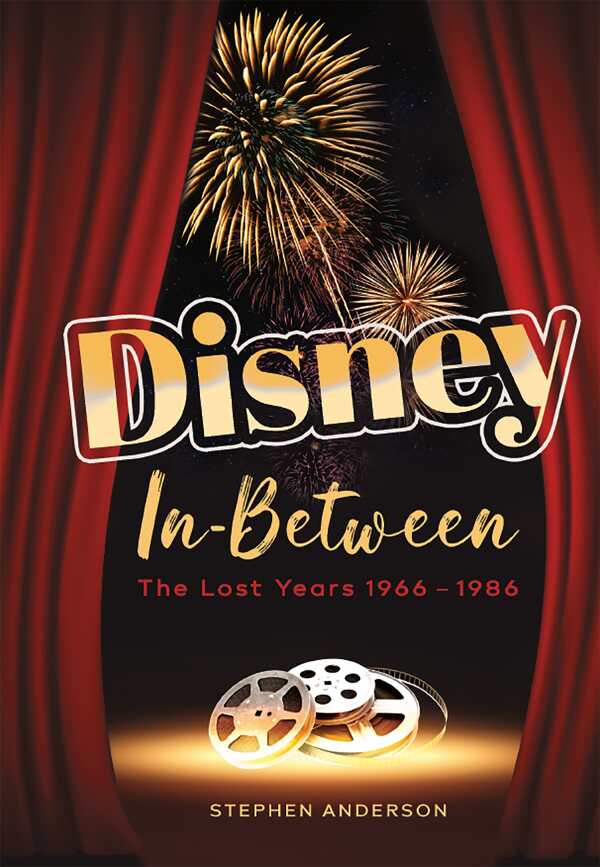Disney In-Between
The Lost Years 1966-1986
Disney In-Between is a exhaustive account of the company’s two-decade transformation, starting with the 1966 death of Walt Disney.
Stephen Anderson’s encyclopedic book Disney In-Between covers the history of the Walt Disney Company’s tumultuous two decades following its founder’s death.
A blow-by-blow account of how the studio wrestled with the competing impulses to preserve its founder’s legacy and carry on his pioneering spirit, the book begins with a crash course in the singular, top-down management style that Disney employed, showing that he had a hand in storyboarding, writing scripts, editing final cuts, and hiring young talent. And by 1986, the company’s post-Walt Disney success seemed clear: it had spun up the iconic Touchstone Films, fended off hostile corporate takeovers, incubated a new generation of talented animators and filmmakers that included Tim Burton, and would soon release classic films like The Little Mermaid and Honey, I Shrunk the Kids. However, Anderson argues that the two decades in between Disney’s death and this period of success were rife with the turmoil and conflicted visions of an evolving company.
The book argues that a lack of clear leadership and reluctance to engage with the wild changes of the 1960s and 1970s led to deadlocks, soured relationships, and unsuccessful films. Emblematic of the confusing period was the committee of eight who took control of Disney’s live action films, replacing Walt Disney’s one-man leadership with an indecisive group that censored riskier new projects and alienated the songwriting duo who had created Mary Poppins. Starting with 1966, each chapter is devoted to a single year, covering its projects, personnel, and other developments. Watershed moments, as with growing dissatisfaction over the Vietnam War bleeding out into mainstream cinema, are highlighted.
Some of the book’s arguments are comparative, as when 1967’s Bonnie and Clyde, representing a new, rebellious trend in filmmaking, is juxtaposed to Disney’s Oscar-nominated film of the same year, Doctor Dolittle, suggesting that the company had become out of touch and was slow to adapt to cultural changes. More evidence is given in the detailed account of how, after shepherding the new CalArts university into existence (one of Walt Disney’s final passion projects), Disney’s brother Roy became offended over news that the school’s artistic community was filled with pot-smoking hippies. These and other stories are told in meticulous detail, drawing on interviews, research, and Anderson’s firsthand experiences.
While its pointed observations and retrospective comparisons are edifying, the book’s progression is overwhelmed by its heft of unprioritized facts, dates, and names. It includes a bevy of minor details within the years of disarray it covers. Indeed, major stories about people including Roy E. Disney Jr., the last standard-bearer of the family name, and Eric Larson, the in-house mentor and stalwart of the animation department, become diluted by their proximity to tangential narratives, as with those that follow child actress Annie McEveety, animator Eric Cleworth (who was almost chosen to direct Winnie the Pooh and Tigger Too), and countless others who had just glancing interactions with the company. And the book’s strict chronological organization results in ample information on specific conflicts, as with that between Tim Burton and the producers of The Black Cauldron over his dark and experimental drawings, but it also muddies the complex, multiyear stories of how such films progressed from inception to release.
A behind-the-scenes history of what went on at the Walt Disney Company after the death of Walt Disney, Disney In-Between is a exhaustive account of a two-decade transformation.
Reviewed by
Willem Marx
Disclosure: This article is not an endorsement, but a review. The publisher of this book provided free copies of the book and paid a small fee to have their book reviewed by a professional reviewer. Foreword Reviews and Clarion Reviews make no guarantee that the publisher will receive a positive review. Foreword Magazine, Inc. is disclosing this in accordance with the Federal Trade Commission’s 16 CFR, Part 255.

